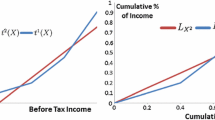Abstract
This paper argues thatthe interaction between inequality and the demand patterns forgoods is a potential source of persistent inequality. Incomedistribution, in the presence of non-homothetic preferences,affects the demand for goods and, due to differences in factorintensities across sectors, it alters the return to factors ofproduction and the initial distribution of income. Low inequalityleads to high demand for medium skilled intensive goods, providinga bridge over which low skill dynasties may transition to thehigh-skilled sector in the long run. Under high inequality however,the initial lack of demand for medium skilled labor breachesthis bridge from poverty to prosperity and inequality persists.
Similar content being viewed by others
References
Aghion, P., and P. Bolton. (1997). “A Theory of Trickle Down Growth and Development,” Review of Economic Studies 64, 151–172.
Andreoni, J. (1989). “Giving with Impure Altruism: Applications to Charity and Ricardian Equivalence,” Journal of Political Economy 97, 1147–1458.
Baland, J-M., and R. Debraj. (1991). “Why Does Asset Inequality Affect Unemployment? A Study of the Demand Composition Problem,” Journal of Development Economics 35, 275–303.
Banerjee, A. V., and A. F. Newman. (1993). “Occupational Choice and the Process of Development,” Journal of Political Economy 101, 274–298.
Banerjee, A. V., and A. F. Newman. (1991). “Risk Bearing and the Theory of Income Distribution,” Review of Economic Studies 58, 211–235.
Benabou, R. (1996). “Inequality and Growth,” NBER Macroeconomics Annual, 11–74.
Carnoy, M. in collaboration with J. Lobo, A. Toledo, and J. Velloso. (1979). Can Educational Policy Equalize Income Distribution in Latin America? Saxon House, International Labor Organisation.
Copeland, B., and A. Kotwal. (1996). “Product Quality and the Theory of Comparative Advantage,” European Economic Review 40, 1747–1760.
Deininger, K., and L. Squire. (1998). “New Ways of Looking at Old Issues: Inequality and Growth,” Journal of Development Economics 107, 259–287.
de Janvry, A., and E. Sadoulet. (1983). “Social Articulation as a Condition for Equitable Growth,” Journal of Development Economics 13, 275–303.
Eswaran, M., and A. Kotwal. (1993). “A Theory of Real Wage Growth in LDCs,” Journal of Development Economics 42, 243–269.
Galor, O., and O. Moav. (1999). “From Physical to Human Capital Accumulation Inequality in the Process of Development,” Brown University, Dept. of Economics, working paper 99–27.
Galor, O., and J. Zeira. (1993). “Income Distribution and Macroeconomics,” Review of Economic Studies 60, 35–52.
Goldin, C., and R. Margo. (1992). “The Wage Structure in the United States at Mid-Century,” Quarterly Journal of Economics 107, 1–34.
Hunter, L. (1991). “The Contribution of Non-Homothetic Preferences to Trade,” Journal of International Economics 30, 345–358.
Kaldor, N. (1957). “Alternative Theories of Distribution,” Review of Economic Studies 23, 83–100.
Keynes, J. M. (1920). The Economic Consequences of Peace. MacMillan and Co.
Kindleberger, C. (1989). Economic Laws and Economic History. Cambridge: Cambridge University Press.
Langoni, C. (1973). A Distribucao da Renda e Desenvolvimento Economico do Brasil. Rio de Janeiro: Editora Expressao e Cultura.
Lluch, C., A. Powell, and R. Williams. (1977). Patterns in Household Demand and Saving. Washington, D.C.: published for the World Bank by Oxford University Press.
Loury, G. C. (1981). “Intergenerational Transfers and the Distribution of Earnings,” Econometrica 49, 843–867.
Mani, A. (1998). “The Impact of Income Distribution and Demand Composition on Economic Development,” Ph.D. Dissertation, Boston University.
Mankiw, G. N., D. Romer, and D.Weil. (1992). “A Contribution to the Empirics of Economic Growth,” Quarterly Journal of Economics 107, 407–437.
Matsuyama, K. (2000). “The Rise of Mass Consumption Societies,” Center for Mathematical Studies in Economics and Management Science, Kellogg Graduate School of Management, Northwestern University, discussion paper no. 1289.
Morley, S., and J. Williamson. (1974). “Demand, Distribution and Employment, The Case of Brazil,” Economic Development and Cultural Change, 33–60.
Murphy, K. J., A. Schleifer, and R. W. Vishny. (1989). “Income Distribution, Market Size and Industrialization,” Quarterly Journal of Economics 103, 537–564.
Owen, A., and D. Weil. (1998). “Intergenerational Earnings Mobility, Inequality and Growth,” Journal of Monetary Economics 41, 71–104.
Piketty, T. “The Dynamics of the Wealth Distribution and the Interest Rate with Credit Rationing,” Review of Economic Studies 64, 173–189.
Shleifer, A., and R. Vishny. (1995). “Quality and Trade,” Journal of Development Economics 8, 1–15.
Talmain, G., and C-H. Chou. (1996). “Redistribution and Growth: Pareto Improvements,” Journal of Economic Growth 1, 505–523.
Teitel, S. (1976). “Labor Homogeneity, Skill Intensity and Factor Reversals-an International Comparison,” Journal of Development Economics 3, 355–366.
Author information
Authors and Affiliations
Rights and permissions
About this article
Cite this article
Mani, A. Income Distribution and the Demand Constraint. Journal of Economic Growth 6, 107–133 (2001). https://doi.org/10.1023/A:1011326523470
Issue Date:
DOI: https://doi.org/10.1023/A:1011326523470




